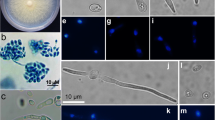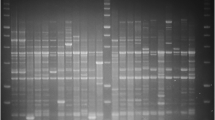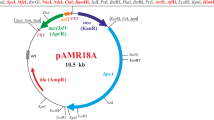Abstract
The deliberate release of genetically engineered microorganisms requires a thorough characterization of the microbes in question. For the two bioluminescentRhizobium meliloti strains, L1 and L33 [Selbitschka et al. (1992) Mol Ecol 1: 9–19; Selbitschka et al. (1995) FEMS Microbiol Ecol 16:223–232], designated for field release, the sites of genetic modifications in the chromosomes were sequenced from amplified genomic DNA. This indicated no unexpected alterations in the nucleotide sequence. The bioluminescent phenotype was stably inherited over more than 100 generations in liquid cultures. The presence of the luciferase gene in both strains did not have secondary effects on a variety of metabolic pathways as assessed by the Biolog GN system. A specific polymerase chain reaction amplification, based on the chromosomal insertion site of theluc cassette, allowed the discrimination between the two strains and thus simplifies monitoring. The RecA-deficient strain L1 showed a strongly (more than 90%) reduced ability to nodulate alfalfa in competition with its parent strainR. meliloti 2011 and its RecA+ counterpart L33.
Similar content being viewed by others

References
Bochner B (1989) “Breathprints” at the microbial level. Am Soc Microbiol News 55:536–539
Kosier B, Pühler A, Simon R (1993) Monitoring the diversity ofRhizobium meliloti field and microcosm isolates with a novel rapid genotyping method using insertion elements. Mol Ecol 2:35–46
Meade H, Long S, Ruvkun G, Brown S, Ausubel F (1982) Physical and genetic characterization of symbiotic and auxotrophic mutants ofRhizobium meliloti induced by transposon Tn5 mutagenesis. J Bacteriol 149:114–122
Molin S, Kjellegard S (1993) Release of engineered microorganisms: biological containment and improved predictability for risk assessment. Ambio 22:242–245
Pearson WR, Lipman DJ (1988) Improved tools for biological sequence analysis. Proc Natl Acad Sci USA 85:2444–2448
Sambrook J, Fritsch EF, Maniatis T (1989) Molecular cloning: a laboratory manual, 2nd edn. Cold Spring Harbor Laboratory, Cold Spring Harbor NY
Selbitschka W, Pühler A, Simon R (1992) The construction ofrecA-deficientRhizobium meliloti andRhizobium leguminosarum strains marked withgusA orluc cassettes for use in risk-assessment studies. Mol Ecol 1:9–19
Selbitschka W, Dresing U, Hagen M, Niemann S, Pühler A (1995) A biological containment system forRhizobium meliloti based on the use of recombination-deficient (recA−) strains. FEMS Microbiol Ecol 16:223–232
Triplett EW, Sadowsky MJ (1992) Genetics of competition for nodulation of legumes. Annu Rev Microbiol 46:399–428
Vincent JM (1970) A manual for the practical study of root nodule bacteria. IBP handbook no 15. Blackwell, Oxford
Zimmermann J, Voss H, Schwaiger C, Stegemann J, Erfle H, Stucky K, Kristensen T, Ansorge W (1990) A simplified method protocol for fast plasmid DNA sequencing. Nucleic Acids Res 18:1067
Author information
Authors and Affiliations
Rights and permissions
About this article
Cite this article
Dammann-Kalinowski, T., Niemann, S., Keller, M. et al. Characterization of two bioluminescentRhizobium meliloti strains constructed for field releases. Appl Microbiol Biotechnol 45, 509–512 (1996). https://doi.org/10.1007/BF00578463
Received:
Revised:
Accepted:
Issue Date:
DOI: https://doi.org/10.1007/BF00578463



